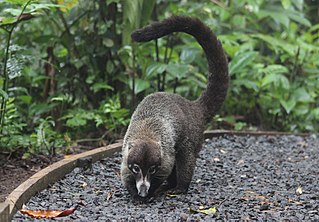
Coatis, also known as coatimundis, are members of the family Procyonidae in the genera Nasua and Nasuella. They are diurnal mammals native to South America, Central America, Mexico, and the southwestern United States. The name "coatimundi" comes from the Tupian languages of Brazil, where it means "lone coati". Locally in Belize, the coati is known as "quash".

The African golden cat is a wild cat endemic to the rainforests of West and Central Africa. It is threatened due to deforestation and bushmeat hunting and listed as Vulnerable on the IUCN Red List. It is a close relative of both the caracal and the serval. Previously, it was placed in the genus Profelis. Its body size ranges from 61 to 101 cm with a 16 to 46 cm long tail.

The bay duiker, also known as the black-striped duiker and the black-backed duiker, is a forest-dwelling duiker native to western and southern Africa. It was first described by British zoologist John Edward Gray in 1846. Two subspecies are identified. The bay duiker is reddish-brown and has a moderate size. Both sexes reach 44–49 cm (17–19 in) at the shoulder. The sexes do not vary considerably in their weights, either; the typical weight range for this duiker is 18–23 kg (40–51 lb). Both sexes have a pair of spiky horns, measuring 5–8 cm (2.0–3.1 in). A notable feature of this duiker is the well-pronounced solid stripe of black extending from the back of the head to the tail.

The marsh mongoose, also called water mongoose is a medium-sized mongoose species native to sub-Saharan Africa that inhabits freshwater wetlands. It has been listed as Least Concern on the IUCN Red List since 2008.

The African brush-tailed porcupine is a species of rat-like Old World porcupine, indigenous to a broad belt of Africa ranging from Guinea on the west coast to Kenya on the east. This is a common species with a very wide range, and despite it being used extensively for bushmeat, the International Union for Conservation of Nature has rated its conservation status as being of "least concern".

The stripe-necked mongoose is a mongoose species native to forests and shrublands from southern India to Sri Lanka.
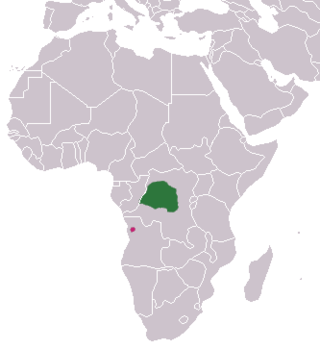
The Angolan kusimanse, also known as Ansorge's kusimanse, is a species of small mongoose. There are two recognized subspecies: C. a. ansorgei, found in Angola; and C. a. nigricolor, found in DR Congo, which do not have overlapping ranges. It prefers rainforest type habitat, and avoids regions inhabited by humans. It grows to 12–18 inches in length, with a 6–10 inch long tail, and weighs 1–3 lb. Little is known about this species of kusimanse, and there are no estimates of its wild population numbers or status. Until 1984, the species was only known from two specimens from Baringa but are now thought to be quite common in some regions. Threats are probably habitat loss and bushmeat hunting. However, this species is protected by Salonga National Park.

Alexander's kusimanse is a mongoose species native to Central African rainforests up to an elevation of 2,900 m (9,500 ft).
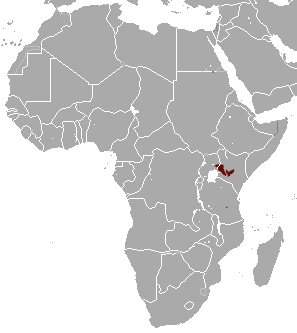
Jackson's mongoose is a mongoose species native to montane forests in Kenya, Uganda and Tanzania. It appears to be rare and has been classified as Near Threatened since 2008.

Pousargues's mongoose, also known as the African tropical savannah mongoose, is a mongoose native to Central Africa. It is listed as data deficient on the IUCN Red List as little is known about its distribution and ecology. It is the only species in the genus Dologale.

The Cape grey mongoose, also called the small grey mongoose, is a small mammal native to South Africa, Lesotho and southern Namibia.

The short-tailed mongoose is a mongoose species native to Peninsular Malaysia, Sumatra and Borneo. It inhabits evergreen forest and rural gardens from sea level to an elevation of 1,500 m (4,900 ft). It is listed as Near Threatened on the IUCN Red List since 2008.

The Indian brown mongoose or brown mongoose is a mongoose species native to the Western Ghats in India and the western coast in Sri Lanka and introduced to Fiji. It is listed as least concern on the IUCN Red List.

The ruddy mongoose is a mongoose species native to hill forests in India and Sri Lanka.

The white-tailed mongoose is a species in the mongoose family Herpestidae. It is the only member of the genus Ichneumia.
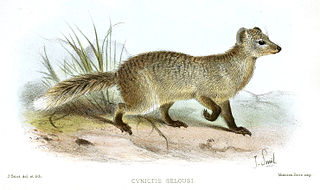
Selous's mongoose is a mongoose species native to Southern Africa. It is the only member of the genus Paracynictis.
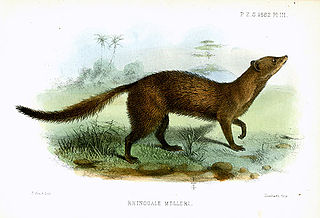
Meller's mongoose is a small brown mongoose native to savannas and woodlands of southeastern Africa. It is the only member of the genus Rhynchogale. The Meller's mongoose lives alone and is active at night, feeding on termites or other small insects and animals. While somewhat rare, it is adaptable and faces no serious threats. It is a member of the mongoose family (Herpestidae), a group of fox-like animals native to Asia, southern Europe, and Africa.

Bates's pygmy antelope, also known as the dwarf antelope, pygmy antelope or Bates' dwarf antelope, is a very small antelope living in the moist forest and brush of Central and West Africa. It is in the same genus as the suni.

Bates's nightjar or the forest nightjar, is a bird species of the family Caprimulgidae, found in the rainforests of western Sub-Saharan Africa.




















